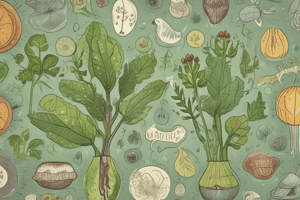Podcast
Questions and Answers
What is Photosynthesis?
What is Photosynthesis?
The process by which green plants use energy from the sun to change carbon dioxide and water into glucose and oxygen.
The chemical formula for Photosynthesis is: 6CO2 + 6H2O → ______ + 6O2
The chemical formula for Photosynthesis is: 6CO2 + 6H2O → ______ + 6O2
C6H12O6
What are the three types of Carbohydrates?
What are the three types of Carbohydrates?
Monosaccharides contain one sugar unit.
Monosaccharides contain one sugar unit.
Signup and view all the answers
What is the chemical formula of a monosaccharide?
What is the chemical formula of a monosaccharide?
Signup and view all the answers
Which of the following are the three monosaccharides?
Which of the following are the three monosaccharides?
Signup and view all the answers
How are Disaccharides formed?
How are Disaccharides formed?
Signup and view all the answers
Which of the following are disaccharides?
Which of the following are disaccharides?
Signup and view all the answers
The chemical formula for Disaccharides is: ______
The chemical formula for Disaccharides is: ______
Signup and view all the answers
Polysaccharides are formed when three or more monosaccharides join together.
Polysaccharides are formed when three or more monosaccharides join together.
Signup and view all the answers
Which of the following are examples of polysaccharides?
Which of the following are examples of polysaccharides?
Signup and view all the answers
Pectin, cellulose, and gums are also known as Non-Starch Polysaccharides.
Pectin, cellulose, and gums are also known as Non-Starch Polysaccharides.
Signup and view all the answers
What are two types of starch chains?
What are two types of starch chains?
Signup and view all the answers
What is the formula for polysaccharides?
What is the formula for polysaccharides?
Signup and view all the answers
What is the culinary application of Glucose?
What is the culinary application of Glucose?
Signup and view all the answers
Sucrose is a monosaccharide.
Sucrose is a monosaccharide.
Signup and view all the answers
What is the culinary application of Starch?
What is the culinary application of Starch?
Signup and view all the answers
What is the culinary application of Pectin?
What is the culinary application of Pectin?
Signup and view all the answers
Which of the following is NOT a property of Non-Starch Polysaccharides?
Which of the following is NOT a property of Non-Starch Polysaccharides?
Signup and view all the answers
What are three properties of Sugar?
What are three properties of Sugar?
Signup and view all the answers
Sugar is a white crystalline compound.
Sugar is a white crystalline compound.
Signup and view all the answers
What is the culinary application of sugar's solubility property?
What is the culinary application of sugar's solubility property?
Signup and view all the answers
All sugars have the same sweetness level.
All sugars have the same sweetness level.
Signup and view all the answers
What is one culinary application of sugar's sweetness property?
What is one culinary application of sugar's sweetness property?
Signup and view all the answers
Aeration occurs when sugar is whisked with egg whites.
Aeration occurs when sugar is whisked with egg whites.
Signup and view all the answers
What is one culinary application of sugar's aeration property?
What is one culinary application of sugar's aeration property?
Signup and view all the answers
What is the non-enzymic browning of food due to a reaction between certain amino acids and sugars under dry heat called?
What is the non-enzymic browning of food due to a reaction between certain amino acids and sugars under dry heat called?
Signup and view all the answers
The Maillard reaction occurs on heating and causes browning.
The Maillard reaction occurs on heating and causes browning.
Signup and view all the answers
What is a culinary application of the Maillard reaction?
What is a culinary application of the Maillard reaction?
Signup and view all the answers
Caramelisation is the process where sugar is heated at high temperatures causing a change in colour and texture.
Caramelisation is the process where sugar is heated at high temperatures causing a change in colour and texture.
Signup and view all the answers
What is one culinary application of caramelisation?
What is one culinary application of caramelisation?
Signup and view all the answers
Crystallisation occurs when liquid has dissolved as much sugar as it can, and is saturated.
Crystallisation occurs when liquid has dissolved as much sugar as it can, and is saturated.
Signup and view all the answers
What is the culinary application of Crystallisation?
What is the culinary application of Crystallisation?
Signup and view all the answers
Hydrolysis is the reverse of condensation.
Hydrolysis is the reverse of condensation.
Signup and view all the answers
Hydrolysis occurs during digestion.
Hydrolysis occurs during digestion.
Signup and view all the answers
What is one culinary application of Hydrolysis?
What is one culinary application of Hydrolysis?
Signup and view all the answers
Inversion occurs when liquid sucrose solution is heated in the presence of an acid or enzyme, causing the sucrose to spilt into glucose and fructose.
Inversion occurs when liquid sucrose solution is heated in the presence of an acid or enzyme, causing the sucrose to spilt into glucose and fructose.
Signup and view all the answers
What is one culinary application of Inversion?
What is one culinary application of Inversion?
Signup and view all the answers
Which of these is NOT a property of Starch?
Which of these is NOT a property of Starch?
Signup and view all the answers
Starch is insoluble in cold water.
Starch is insoluble in cold water.
Signup and view all the answers
Starch is hygroscopic, meaning it is able to absorb moisture.
Starch is hygroscopic, meaning it is able to absorb moisture.
Signup and view all the answers
Dextrins are shorter chains of starch.
Dextrins are shorter chains of starch.
Signup and view all the answers
What is the culinary application of Dextrinisation?
What is the culinary application of Dextrinisation?
Signup and view all the answers
Gelatinisation occurs when starch is heated in the presence of water, where the starch grains swell and thicken the liquid.
Gelatinisation occurs when starch is heated in the presence of water, where the starch grains swell and thicken the liquid.
Signup and view all the answers
What is one culinary application of Gelatinisation?
What is one culinary application of Gelatinisation?
Signup and view all the answers
What is the definition of Hydrolysis in relation to carbohydrates?
What is the definition of Hydrolysis in relation to carbohydrates?
Signup and view all the answers
Due to hydrolysis, disaccharides become monosaccharides.
Due to hydrolysis, disaccharides become monosaccharides.
Signup and view all the answers
Cellulose is soluble in water.
Cellulose is soluble in water.
Signup and view all the answers
Cellulose can be digested by the human body.
Cellulose can be digested by the human body.
Signup and view all the answers
What is the definition of Peristalsis?
What is the definition of Peristalsis?
Signup and view all the answers
Gums are insoluble in water.
Gums are insoluble in water.
Signup and view all the answers
Pectin is a naturally present in plant cell walls.
Pectin is a naturally present in plant cell walls.
Signup and view all the answers
Pectin is used as a setting agent in jams and jellies.
Pectin is used as a setting agent in jams and jellies.
Signup and view all the answers
Pectin is only present in fruit when it is overripe.
Pectin is only present in fruit when it is overripe.
Signup and view all the answers
Carbohydrates are used for energy.
Carbohydrates are used for energy.
Signup and view all the answers
Carbohydrates can be used for growth and repair.
Carbohydrates can be used for growth and repair.
Signup and view all the answers
Excess carbohydrates are changed to glycogen and stored in liver and muscle.
Excess carbohydrates are changed to glycogen and stored in liver and muscle.
Signup and view all the answers
Excess carbohydrates can be changed to body fat and stored in adipose tissue.
Excess carbohydrates can be changed to body fat and stored in adipose tissue.
Signup and view all the answers
Cellulose can help with constipation.
Cellulose can help with constipation.
Signup and view all the answers
What is one enzyme that breaks starch into Maltose.
What is one enzyme that breaks starch into Maltose.
Signup and view all the answers
What is one enzyme that breaks Maltose into Glucose.
What is one enzyme that breaks Maltose into Glucose.
Signup and view all the answers
Monosaccharides are most easily absorbed into the blood stream.
Monosaccharides are most easily absorbed into the blood stream.
Signup and view all the answers
Monosaccharides are absorbed through the villi of the small intestine into the blood stream.
Monosaccharides are absorbed through the villi of the small intestine into the blood stream.
Signup and view all the answers
What is one of the three elements found in carbohydrates?
What is one of the three elements found in carbohydrates?
Signup and view all the answers
Name one health problem caused by a diet high in sugar.
Name one health problem caused by a diet high in sugar.
Signup and view all the answers
Name one effect of high sugar consumption on the body.
Name one effect of high sugar consumption on the body.
Signup and view all the answers
Glucose releases heat and ______.
Glucose releases heat and ______.
Signup and view all the answers
Excess glucose is stored as energy in the ______ and muscles.
Excess glucose is stored as energy in the ______ and muscles.
Signup and view all the answers
Dietary fibre (Cellulose) ______ the movement of food through the bowel.
Dietary fibre (Cellulose) ______ the movement of food through the bowel.
Signup and view all the answers
What is one digestive enzyme that converts starch to maltose?
What is one digestive enzyme that converts starch to maltose?
Signup and view all the answers
What is one enzyme that breaks sucrose into glucose and fructose?
What is one enzyme that breaks sucrose into glucose and fructose?
Signup and view all the answers
What is one enzyme that breaks lactose into glucose and galactose?
What is one enzyme that breaks lactose into glucose and galactose?
Signup and view all the answers
Study Notes
Carbohydrates
- Carbohydrates are a vital energy source for the body.
- They provide heat and energy needed for bodily functions.
- They spare protein for growth and repair.
- Excess carbohydrates are converted to glycogen, a stored energy, and to adipose tissue.
Photosynthesis
- Photosynthesis is the process used by green plants which transform carbon dioxide and water into glucose and oxygen via sunlight.
- The chemical equation representing this process is 6CO2 + 6H₂O → C₆H₁₂O₆ + 6O₂
- Carbon dioxide enters leaves through stomata.
Classification of Carbohydrates
- Three types of carbohydrates: monosaccharides, disaccharides, and polysaccharides.
Monosaccharides
- A single sugar unit.
- Chemical formula: C₆H₁₂O₆
- Examples: glucose, fructose, galactose
Disaccharides
- Formed when two monosaccharides join together through a condensation reaction (water is released).
- Chemical formula: C₁₂H₂₂O₁₁
- Examples: maltose, sucrose, lactose.
- Maltose: glucose + glucose
- Sucrose: glucose + fructose
- Lactose: glucose + galactose.
Polysaccharides
- Formed by three or more monosaccharides joined together.
- Example: Starch, pectin, cellulose, gums & glycogen
- Starch: made of glucose units, can be amylose (straight chains) or amylopectin (branched chains).
- Non-starch polysaccharides (NSPs): pectin, cellulose, and gums.
Properties of Sugar
- Solubility: Sugar is water-soluble, forming a syrup when a large amount of sugar dissolves in water.
- Flavour/Sweetness: All sugars are sweet; some are notably sweeter than others; this is measured relatively on a scale of 100%. Examples fructose (170%), glucose (75%), and lactose (15%).
- Aeration: Sugar assists in aeration of egg whites, helping to create a temporary foam; this foam becomes permanent with heating. Common use: meringues & sponges.
- Maillard Reaction: A non-enzymatic browning reaction between amino acids and sugars when heated; results in attractive brown colour (in foods like roast potatoes).
- Caramelization: Defined as a gradual transformation when sugar is heated to a brown syrup. This occurs over several stages (104°c - 177°c), most effectively at 160°C Common use: creme caramel & caramel squares.
- Crystallization: Sugar crystals form in a solution when the solution is saturated, and further sugar is added. This is useful in confectionary products (e.g. fudge).
- Hydrolysis: A chemical breakdown by adding water that converts disaccharides into monosaccharides during digestion. For example: lactose broken down into glucose and galactose
- Inversion: A heating process of sucrose solution (presence acid or enzyme), splits into glucose and fructose; resulting in an invert sugar, which is sweeter than sucrose. Common use: jams & jellies due to easy dissolution and thus preventing crystallization.
Properties of Starch
- Flavour: Starch has no discernible sweet taste.
- Solubility: Starch is insoluble in cold water.
- Hygroscopic: Starch absorbs moisture from the air.
- Dextrinisation: A process where heating dextrins leads to longer chains resulting in brown colour (Example: toast).
- Gelatinisation: A thickening process; Starch granules swell and burst in hot water. Example: use of flour to thicken soup or sauces.
- Hydrolysis: A chemical breakdown by adding water that eventually converts starch into simple sugars (e.g. maltose).
Dietary Fibre/Cellulose
- Cellulose (Dietary Fibre) is insoluble in water.
- It adds bulk to the diet and promotes satiety.
- It absorbs water whilst passing through the intestines aiding in peristalsis (muscular contractions of intestines that move food).
Gums
- Gums are water-soluble and absorb large amounts of water, creating thick, firm gels.
- Examples: Culinary applications include salad dressings, ice creams.
Properties of Pectin
- Pectin is found in plant cell walls of fruit and vegetables, acting as a gelling agent in jams and jellies.
- The gelling ability comes from the pectin's ability to absorb water to form a gel.
- A key point: pectin only appears when the fruits are ripe. It is protopectin in under ripe fruits and pectin acid in overripe fruits.
- For extraction, pectin requires heat and acid (e.g., lemon juice).
- Culinary application: jam-making
Other Properties of Non-Starch Polysaccharides – Summary
- General: Non-starch polysaccharides have various functions in food.
- Gel-Formation: some form gels (adding to texture in jams, jellies, etc.).
- Textural properties: Cellulose provides texture, like in cereals, and gives a feeling of fullness.
- Moisture absorption: Cellulose and other NSPs absorb water, giving fullness and influencing food's ability to absorb moisture from the surrounding environment..
Biological Functions of Carbohydrates
- Carbohydrates provide energy.
- They spare proteins to be used in building processes.
- Excess carbohydrates are stored as glycogen in the liver and muscles.
- Excess carbohydrates are also stored as fat.
- Cellulose moves food through the intestine.
Digestion of Carbohydrates
- Mouth: Teeth physically break down food, salivary amylase breaks starch into maltose.
- Stomach: Food is churned.
- Intestine: Pancreatic amylase breaks starch into maltose; maltose into glucose; Sucrose into glucose & fructose; Lactose into glucose & galactose.
Absorption
- Monosaccharides are absorbed into the blood stream via intestinal villi. They are transported to the liver through the portal vein.
Utilisation of Carbohydrates
- Monosaccharides are oxidised which releases heat and energy (cellular respiration).
- Some monosaccharides are converted to glycogen as an energy reserve.
- Excess carbohydrate is converted to fat and stored as energy reserves.
Culinary Uses of Sugar
- Sweetener
- Preservative
- Caramelisation
- Custard
- Fermentation
- Gel-Formation
- Colour
Culinary Uses of Starch
- Thickener (sausages, soups, stews)
- Hygroscopic (absorbing moisture in baked goods)
- Dextrinisation (browning of certain foods like toast)
Culinary Uses of Non-Starch Polysaccharides
- Gel-formation (in jams, pectin forms gel in acid and sugar)
- Cellulose (providing texture in cereals and giving a sense of fullness)
Effects of Heat on Carbohydrates
- Dry Heat: Carbohydrates brown in the presence of dry heat, including dextrinization, caramelization, and the Maillard reaction.
- Moist Heat: Carbohydrates soften, swell and burst in moist heat, like cooked vegetables; thickening occurs (e.g., starch gelatinization or pectin extraction for jams).
Questions (Note: these are just the topics of the questions, not complete answers.)
- List of 3 elements in carbohydrates.
- Carbohydrate classification, dietary sources.
- Classification of carbohydrates (chemical formula, examples, food sources).
- Carbohydrate properties.
- Properties of sugar (3 properties, culinary uses).
- Properties of starch (3 properties, culinary uses).
- Non-Starch polysaccharides, properties, and uses.
- Effects of heat on carbohydrates.
- Culinary uses of sugar, starch, and non-starch polysaccharides
- Biological functions of carbohydrates
- Digestion of carbohydrates
- Absorption of carbohydrates
- Utilization of carbohydrates
- Health problems due to high sugar intake.
- Effects of high sugar consumption.
- Digestive enzyme converting starch to maltose.
- Digestion of carbohydrates – table completion.
Studying That Suits You
Use AI to generate personalized quizzes and flashcards to suit your learning preferences.
Related Documents
Description
This quiz covers the essential concepts of carbohydrates and their classification, including monosaccharides, disaccharides, and polysaccharides. Additionally, it explores the process of photosynthesis, highlighting its significance in energy transformation within plants. Test your knowledge on these vital biological processes!





